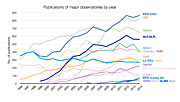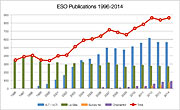Announcement
ESO Remains World’s Most Productive Ground-based Observatory
5 March 2015
A survey of the number of peer-reviewed scientific papers published in 2014 using data from ESO’s telescopes and instruments has shown that ESO remains the world’s most productive ground-based observatory. Astronomers used observational data from ESO facilities to produce 864 refereed papers last year, equalling the all-time high of 2012. The number of papers published from ESO data in 2014 has even remained slightly higher than the number of papers published based on data from the NASA/ESA Hubble Space Telescope.
Nearly 65% of all papers credited to ESO in 2014 used data acquired with the Very Large Telescope (VLT) or VLT Interferometer facilities. The most productive VLT instruments in terms of papers are UVES and FORS2 with VIMOS in third place. In addition GIRAFFE and SINFONI both show strong upwards trends.
The VISTA survey telescope on Paranal provided data for almost twice as many papers as in 2013. FEROS, SOFI and WFI also saw increases, while HARPS remains La Silla’s most productive instrument. Facilities located at La Silla provided data for more than 260 papers in total.
The total number of papers based on European observing time with the Atacama Large Millimeter/submillimeter Array (ALMA) has climbed substantially to a total of 104 at the end of 2014.
The Atacama Pathfinder Experiment telescope (APEX), operated by ESO on the Chajnantor Plateau in Chile’s Atacama region — a collaboration between the Max Planck Institute for Radio Astronomy, the Onsala Space Observatory and ESO — has seen a slight increase in ESO publications since last year, with more than half of all the papers published resulting from ESO observing time.
The methods used to obtain these numbers vary across the different observatories, so the figures cannot always be compared precisely. However, ESO continues to significantly surpass any other ground-based observatory and remains slightly ahead of the NASA/ESA Hubble Space Telescope. These results highlight ESO’s major contributions to astronomical research. The publication statistics give an idea of how much scientific work is carried out with data from the individual observatories, but do not address the wider impact they have on science.
The figures are published in the annual Basic ESO Publication Statistics [1] published by ESO’s Library and calculated using the ESO Telescope Bibliography (telbib), a database containing refereed publications that use ESO data [2]. ESO makes extensive efforts to identify all refereed papers that use ESO data and considers telbib essentially complete.
Interactive graphs of selected statistics are also available online. These graphs display the entire content of the telbib database [3], which contains records for publications from the year 1996 to the present. They can be used to explore many aspects of the publication history, including the development of science papers using data from ESO instruments and the use of archival data.
Notes
[1] Basic ESO Publication Statistics
[2] Tellib information and access to the database
[3] Interactive telbib statistics
Contacts
Uta Grothkopf
ESO Librarian
Garching bei München, Germany
Tel: +49 89 3200 6280
Email: uta.grothkopf@eso.org
Richard Hook
ESO Public Information Officer
Garching bei München, Germany
Tel: +49 89 3200 6655
Cell: +49 151 1537 3591
Email: rhook@eso.org
About the Announcement
| Id: | ann15014 |
Our use of Cookies
We use cookies that are essential for accessing our websites and using our services. We also use cookies to analyse, measure and improve our websites’ performance, to enable content sharing via social media and to display media content hosted on third-party platforms.
ESO Cookies Policy
The European Organisation for Astronomical Research in the Southern Hemisphere (ESO) is the pre-eminent intergovernmental science and technology organisation in astronomy. It carries out an ambitious programme focused on the design, construction and operation of powerful ground-based observing facilities for astronomy.
This Cookies Policy is intended to provide clarity by outlining the cookies used on the ESO public websites, their functions, the options you have for controlling them, and the ways you can contact us for additional details.
What are cookies?
Cookies are small pieces of data stored on your device by websites you visit. They serve various purposes, such as remembering login credentials and preferences and enhance your browsing experience.
Categories of cookies we use
Essential cookies (always active): These cookies are strictly necessary for the proper functioning of our website. Without these cookies, the website cannot operate correctly, and certain services, such as logging in or accessing secure areas, may not be available; because they are essential for the website’s operation, they cannot be disabled.
Functional Cookies: These cookies enhance your browsing experience by enabling additional features and personalization, such as remembering your preferences and settings. While not strictly necessary for the website to function, they improve usability and convenience; these cookies are only placed if you provide your consent.
Analytics cookies: These cookies collect information about how visitors interact with our website, such as which pages are visited most often and how users navigate the site. This data helps us improve website performance, optimize content, and enhance the user experience; these cookies are only placed if you provide your consent. We use the following analytics cookies.
Matomo Cookies:
This website uses Matomo (formerly Piwik), an open source software which enables the statistical analysis of website visits. Matomo uses cookies (text files) which are saved on your computer and which allow us to analyze how you use our website. The website user information generated by the cookies will only be saved on the servers of our IT Department. We use this information to analyze www.eso.org visits and to prepare reports on website activities. These data will not be disclosed to third parties.
On behalf of ESO, Matomo will use this information for the purpose of evaluating your use of the website, compiling reports on website activity and providing other services relating to website activity and internet usage.
Matomo cookies settings:
Additional Third-party cookies on ESO websites: some of our pages display content from external providers, e.g. YouTube.
Such third-party services are outside of ESO control and may, at any time, change their terms of service, use of cookies, etc.
YouTube: Some videos on the ESO website are embedded from ESO’s official YouTube channel. We have enabled YouTube’s privacy-enhanced mode, meaning that no cookies are set unless the user actively clicks on the video to play it. Additionally, in this mode, YouTube does not store any personally identifiable cookie data for embedded video playbacks. For more details, please refer to YouTube’s embedding videos information page.
Cookies can also be classified based on the following elements.
Regarding the domain, there are:
- First-party cookies, set by the website you are currently visiting. They are stored by the same domain that you are browsing and are used to enhance your experience on that site;
- Third-party cookies, set by a domain other than the one you are currently visiting.
As for their duration, cookies can be:
- Browser-session cookies, which are deleted when the user closes the browser;
- Stored cookies, which stay on the user's device for a predetermined period of time.
How to manage cookies
Cookie settings: You can modify your cookie choices for the ESO webpages at any time by clicking on the link Cookie settings at the bottom of any page.
In your browser: If you wish to delete cookies or instruct your browser to delete or block cookies by default, please visit the help pages of your browser:
Please be aware that if you delete or decline cookies, certain functionalities of our website may be not be available and your browsing experience may be affected.
You can set most browsers to prevent any cookies being placed on your device, but you may then have to manually adjust some preferences every time you visit a site/page. And some services and functionalities may not work properly at all (e.g. profile logging-in, shop check out).
Updates to the ESO Cookies Policy
The ESO Cookies Policy may be subject to future updates, which will be made available on this page.
Additional information
For any queries related to cookies, please contact: pdprATesoDOTorg.
As ESO public webpages are managed by our Department of Communication, your questions will be dealt with the support of the said Department.


